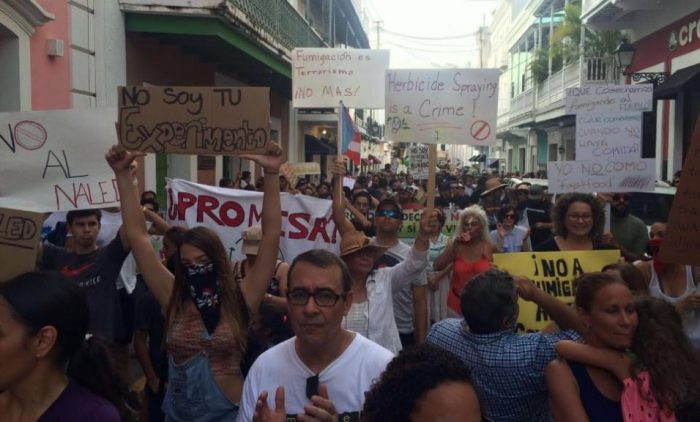Effectively combating emerging climate and health threats requires public trust in science and the scientific institutions charged with protecting us. When that trust is breached through negligence or outright malicious intent and the lives of people are compromised, public distrust grows, hurting the ability of public health agencies to protect us. Unfortunately, the historical legacy of medical research misconduct and environmental contamination by US government agencies in Puerto Rico is hampering current efforts to control the Zika virus in the US territory, an emerging vector-borne disease at the intersection of climate and health threats.
You may have seen Zika making headlines lately due to its causal relationship to microcephaly and other severe brain defects, diseases that can severely damage the nervous system in unborn babies if pregnant mothers become infected. The possibility of a Zika outbreak is especially concerning to the Centers for Disease Control (CDC) because one of its vectors, the Aedes aegypti mosquito, is the same that spreads dengue and chikungunya, which has been well-established in Puerto Rico for decades. In fact, Puerto Rico has endured four large dengue epidemics since 1990, where it continues to be an endemic disease.
Underscoring the threat to the United States is research that suggests that under a changing climate, “mosquito vectors would be present for a larger portion of the year in North America” than they had been in the past. Coupled with the ease of transit between the United States and Puerto Rico, the disease-transmitting mosquitoes are a latent threat that public health agencies in the US are trying to get a handle on. Indeed, as of July 1, 2016, the Puerto Rico Department of Health (PRDOH) reported a total of 2,387 confirmed Zika cases.
But the CDC and the PRDOH have recently come under fire from broad sectors of Puerto Rico’s civil society after announcing their intent to conduct aerial spraying (“fogging”) over the island using naled, an organophosphate pesticide with potential toxicity to humans and debatable effectiveness in controlling Aedes aegypti populations. The EPA has stated that recent naled tests in Puerto Rico were highly effective in controlling mosquito populations. However, the agency deemed naled unsafe for use in or around the home, precisely the habitats that Aedes aegypti prefers, according to Dr. Duane Gubler, who conducted a similar, dengue-focused naled spraying campaign for the CDC in Puerto Rico in 1987: “The [Aedes aegypti] mosquito lives in closets, inside garbage, indoors…[t]hose conditions are less than ideal for mass spraying campaigns”.
Naled is also a “broad spectrum” insecticide, meaning that while it can be effective in killing mosquitoes, it can also adversely affect beneficial insects like bees, pollinators of citrus and coffee plants, important agricultural commodities in Puerto Rico. There’s also a lot of concern about naled’s potential to adversely affect humans.

Puerto Rican civil society is demanding solutions to Zika that do not include pesticide spraying.
It would be beneficial for this scientific information, along with the uncertainties around risks and lack of clear consensus on naled’s effectiveness in controlling mosquitoes, to inform the debate in Puerto Rico around what would be the most appropriate public health intervention against Zika and other similar diseases. But unfortunately, in Puerto Rico, agencies like EPA and CDC are not perceived as trusted messengers of human and environmental health.
How do we explain this mistrust of public health and environmental protection agencies? Well, it may shock many of us to learn that a long history of past medical and environmental experimentation on Puerto Rican people and environments enabled by U.S. agencies is bearing heavily on this issue, and as a result many Puerto Ricans believe that the purpose of the fogging campaign is to use us as guinea pigs to experiment with naled.
Sounds like the stuff of conspiracy theories, doesn’t it? Let’s explore the historical record first…
The specter of scientific racism haunts the present
Eugenics—the “scientific racism” ideology popular during the early 20th century—posited the idea that human progress depended on selective breeding of certain races, and provided justification for unethical medical interventions and experimentation on the morally or “socially inadequate”. The development of a Model Eugenical Sterilization Law codified the sterilization of women in 30 US states and Puerto Rico, with the objectives of reducing poverty through birth control and more economically integrating women into the workforce (by eliminating childcare costs).
Other chapters in the sad history of human experimentation by the US on Puerto Ricans are, after almost a century, still clouded in controversy, and the facts remain muddled. Still, it’s difficult for Puerto Ricans to forget the disparaging comments and allegations about clinical subjects made by Dr. Cornelius “Dusty” Rhoads, in an unsent letter he wrote to a colleague in 1931:
“They [Puerto Ricans] are beyond doubt the dirtiest, laziest, most degenerate and thievish race of men ever inhabiting this sphere. It makes you sick to inhabit the same island with them…What the island needs is not public health work but a tidal wave or something to totally exterminate the population. It might then be livable. I have done my best to further the process of extermination by killing off 8 and transplanting cancer into several more.”
Dr. Rhoads, an oncologist, was at the time in Puerto Rico conducting clinical research on cancer at the Presbyterian Hospital (now Ashford Presbyterian) under the auspices of the Rockefeller Foundation. The letter was made public after it was found, unsent, in his office, by hospital staff, and unleashed a scandal in Puerto Rico. Although Dr. Rhoads’ allegations of genocide were never substantiated in the investigation that followed the scandal, Puerto Ricans remain highly suspicious of the whole affair.* Adding insult to injury, in 1949 Time magazine dedicated a cover to Dr. Rhoads, and it was not until 2002 that the American Association for Cancer Research removed Rhoads’ name from an award for cancer research after renewed interest in the case provoked outcry.
If we add to this the protracted struggles around environmental contamination from air-sea-battle exercises conducted for over 60 years in the island towns of Vieques and Culebra by the U.S. Navy, and the campaign to test Agent Orange’s effectiveness in tropical defoliation in Puerto Rico previous to use in the Vietnam War, and cloud-seeding experiments, it is not difficult to understand how the troubled relationship between U.S. government science and the Puerto Rican population is fueling mistrust of both the intentions and methods of federal agencies in their response to the Zika crisis.
Increasing accountability and transparency in public health decisions
In light of the history of contamination of Puerto Rican human bodies and environments, and the need for an adequate response to the emerging Zika threat that considers the needs and concerns of the population—while separating scientific fact from speculation—how do we move forward?
Dr. Jorge Colón, Professor in the Department of Chemistry at the University of Puerto Rico, has said in a Spanish-language video circulated on social media that there needs to be an open public information process providing specific information to answer, among others, the following questions:
- What are the proposed quantities of naled to be used?
- What are the specific geographical areas targeted for fogging?
- What protections should be taken to minimize risks to children and the general population?
- At what time of day or night can the population leave their homes or return to work after fogging has been conducted?
According to Dr. Colón, none of this information has been forthcoming from the CDC, the PRDOH, or any other US or Puerto Rico government authority, and there is no clarity on who makes the final decision on approving aerial spraying over the territory. There is a need for government agencies, both from the US and Puerto Rico governments, to publicly disclose to the population the extent and details of the proposed naled fogging campaign, as well as explain what other options are being considered as part of the campaign to control mosquito populations that transmit vector-borne diseases. Public outcry in the island is motivated by a demand for transparency in the process and reassurance that the excesses of US government-led science of the past are not repeated.
*A full, book-length account of this case is available in Aponte-Vázquez, P. (2012). The Unsolved Case of Dr. Cornelius P. Rhoads: An Indictment. Publicaciones REN.
